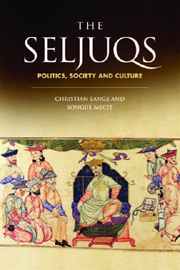Book contents
- Frontmatter
- Contents
- List of figures
- Acknowledgements
- List of abbreviations
- INTRODUCTION
- PART I POLITICS
- PART II SOCIETY
- Part III CULTURE
- 11 SHIˁI JURISPRUDENCE DURING THE SELJUQ PERIOD: REBELLION AND PUBLIC ORDER IN AN ILLEGITIMATE STATE
- 12 IN DEFENCE OF SUNNISM: AL-GHAZĀLĪ AND THE SELJUQS
- 13 ARABIC AND PERSIAN INTERTEXTUALITY IN THE SELJUQ PERIOD: ḤAMĪDĪ'S MAQĀMĀT AS A CASE STUDY
- 14 CITY BUILDING IN SELJUQ RUM
- 15 THE SELJUQ MONUMENTS OF TURKMENISTAN
- Index
14 - CITY BUILDING IN SELJUQ RUM
from Part III - CULTURE
Published online by Cambridge University Press: 12 September 2012
- Frontmatter
- Contents
- List of figures
- Acknowledgements
- List of abbreviations
- INTRODUCTION
- PART I POLITICS
- PART II SOCIETY
- Part III CULTURE
- 11 SHIˁI JURISPRUDENCE DURING THE SELJUQ PERIOD: REBELLION AND PUBLIC ORDER IN AN ILLEGITIMATE STATE
- 12 IN DEFENCE OF SUNNISM: AL-GHAZĀLĪ AND THE SELJUQS
- 13 ARABIC AND PERSIAN INTERTEXTUALITY IN THE SELJUQ PERIOD: ḤAMĪDĪ'S MAQĀMĀT AS A CASE STUDY
- 14 CITY BUILDING IN SELJUQ RUM
- 15 THE SELJUQ MONUMENTS OF TURKMENISTAN
- Index
Summary
After more than a century of instability, the Rum Seljuq state came into its own subsequent to the Third Crusade. In the period after the Fourth Crusade, starting after 1211, peace with the Laskarid state to the west allowed the Seljuqs to expand north, south and, especially, east. This chapter concerns this period of prosperity at the beginning of the 13th century, during which so much of Rum Seljuq building took place. In it, I would like to focus principally on the epigraphic programme of some of the cities that the Seljuqs rebuilt in the roughly twenty-year period between the mid-1210s and mid-1230s. Using the inscriptions on city walls, gates and citadels, this chapter aims to establish parameters for an examination of the Rum Seljuq building apparatus and the relationship between official and personal, state and military, patronage. In the end, it hopes to use building inscriptions as a means to shed light on the Rum Seljuq elite itself.
In medieval Anatolia, building meant rebuilding, recasting and recycling. The Seljuqs of Rum may have learned architectural recycling from the Byzantines, who had long plundered the stone blocks of buildings from earlier eras for the stuff, and ornament, of their buildings. The quantity of building undertaken by the Rum Seljuqs during this period is unthinkable without this thrifty building principle in mind.
In discussing Rum Seljuq urbanism, it is important to remember four factors: existing urban fabric, walls, labour and patronage.
- Type
- Chapter
- Information
- The SeljuqsPolitics, Society and Culture, pp. 256 - 276Publisher: Edinburgh University PressPrint publication year: 2011



